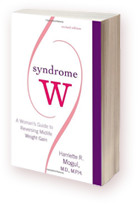What Is Syndrome W
Syndrome W represents a cluster of clinical components that start to appear as women begin to experience the earliest symptoms of menopause, a period called perimenopause. The syndrome's name captures its key elements:
- Weight gain
- Waist gain
- White-coat hypertension (blood pressure elevations at the doctor's office)
- in Women.
One additional symptom is a universal feature of Syndrome W, and that's a dramatic increase in appetite or the development onew food cravings, especially for sweets and carbohydrates. For most midlife women who ate normally before, this can lead to out-of-control (or binge) eating.
If you have Syndrome W, you may find that when you take "just a taste" of the sugar-laced, "low-fat" foods that have proliferated in the past decade, you're unable to stop after just one Oreo or a forkful of fudge cake. This makes it a lot harder to stick to a diet and lose those newly accumulated pounds.
We used the name Syndrome W for another reason. Syndrome W is an early form (and alphabetical precursor) of another, more advanced clinical condition that was originally termed Syndrome X (now known as "the metabolic syndrome"). Both disorders are caused by a metabolic disturbance called "insulin resistance."
The hallmark of Syndrome W is an elevation in insulin levels in the bloodstream (hyperinsulinemia) without the characteristic blood sugar abnormalities that define type 2 diabetes. So if you have Syndrome W, you not only have a metabolic defect, you have a culprit and a cause for your weight gain that's real, not imagined.
But the best part is the happy ending to the Syndrome W story. Syndrome W is not only detectable—it's also completely correctable. You no longer have to tolerate and live with the weight spiral that's the recurring theme of forty- and even thirty-something overweight women. With the Mogul Protocol, our two-pronged program, this midlife malady can be reversed. The earlier you find it, the easier it is to fix Syndrome W.





